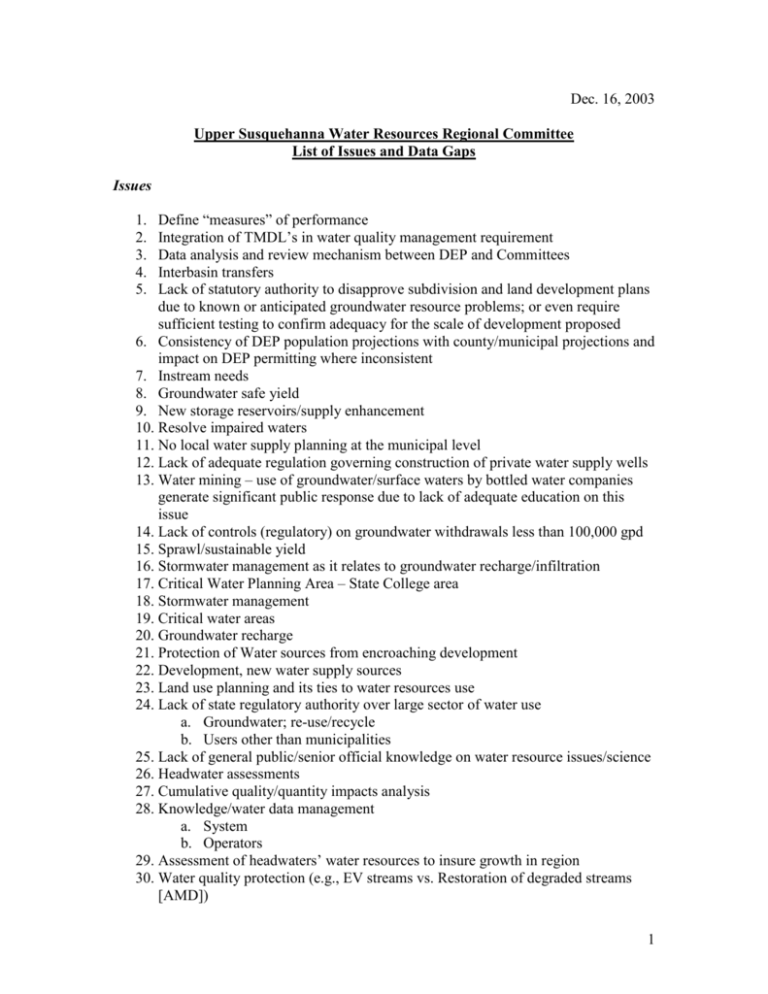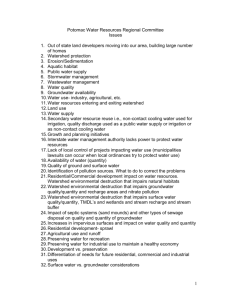Word
advertisement

Dec. 16, 2003 Upper Susquehanna Water Resources Regional Committee List of Issues and Data Gaps Issues Define “measures” of performance Integration of TMDL’s in water quality management requirement Data analysis and review mechanism between DEP and Committees Interbasin transfers Lack of statutory authority to disapprove subdivision and land development plans due to known or anticipated groundwater resource problems; or even require sufficient testing to confirm adequacy for the scale of development proposed 6. Consistency of DEP population projections with county/municipal projections and impact on DEP permitting where inconsistent 7. Instream needs 8. Groundwater safe yield 9. New storage reservoirs/supply enhancement 10. Resolve impaired waters 11. No local water supply planning at the municipal level 12. Lack of adequate regulation governing construction of private water supply wells 13. Water mining – use of groundwater/surface waters by bottled water companies generate significant public response due to lack of adequate education on this issue 14. Lack of controls (regulatory) on groundwater withdrawals less than 100,000 gpd 15. Sprawl/sustainable yield 16. Stormwater management as it relates to groundwater recharge/infiltration 17. Critical Water Planning Area – State College area 18. Stormwater management 19. Critical water areas 20. Groundwater recharge 21. Protection of Water sources from encroaching development 22. Development, new water supply sources 23. Land use planning and its ties to water resources use 24. Lack of state regulatory authority over large sector of water use a. Groundwater; re-use/recycle b. Users other than municipalities 25. Lack of general public/senior official knowledge on water resource issues/science 26. Headwater assessments 27. Cumulative quality/quantity impacts analysis 28. Knowledge/water data management a. System b. Operators 29. Assessment of headwaters’ water resources to insure growth in region 30. Water quality protection (e.g., EV streams vs. Restoration of degraded streams [AMD]) 1. 2. 3. 4. 5. 1 31. What are trends of consumptive water uses: surface vs. ground water 32. Understanding of current water use and trends, and how this fits with sustainable supply (a process need) 33. Groundwater consumption and planning to address sustainable yield (where are we; what is suggested) 34. Implications of agriculture use (consumptive and non-consumptive), and projected changes over X years – recommendations to address water supply and water quality 35. Issue of stormwater management to address both peak flow management and groundwater recharge 36. Issue of public water supply and interactions (policy, regulation, etc…) with groundwater sustainable supply 37. Acid mine drainage – while a water quality issue, it is the water planning issue in much of Upper Susquehanna, so what could we do within Act 220 requirements to HELP with this issue, e.g. a. Use/treatment of acid mine water b. Combined peak flow/AMD management solutions c. Priority records (i.e., identify “fix” AMD before spending money on some lower priority water resource needs) 38. Water quality 39. Groundwater contaminants from old natural gas wells 40. Ability to interconnect to create better water usage 41. Insured recreational use of river and streams 42. Environmental Management, especially acid mine drainage and combined sewer overflows 43. Land use management – protection of water quality and quantity 44. Effective drought management 45. How will we protect surface and groundwater resources (including wetlands) from water withdrawals, diversions, and other impacts related to the use of water? 46. What additional protections will be applied to the best (i.e., high quality waters and EV water and EV wetlands) waters from water withdrawals, diversions and other impacts related to use of water? 47. How will we integrate water quality protection with water use planning? 48. Incentives for citizens to use less water and procure equipment that reduces water use (reduce, reuse, recycle) 49. Same as 1 for industry and commercial ag 50. Review scientific information regarding nutrient impact on Chesapeake Bay from Susquehanna River 51. If water is plentiful and well managed in PA, how is the state marketing this resource to those industries that require this resource Data Gaps 1. Water use of all user groups 2 2. Groundwater availability 3. Knowledge management of existing studies and other state programs relative to water resources planning 4. Future land use plans 5. What is current budget as known today – need to evaluate it now for region 6. What are projected changes and impacts of use (surface, ground, etc…) on picture of budget 7. Accurate water use data (with emphasis on several sectors such as agricultural use, consumptive use, etc.) 8. Recharge rate data (empirical) and critical aquifer recharge areas. 9. Warm water ecosystem flow methodology: a. Assessing aquatic viability/impacts under low flows b. Something beyond 20% ADF Q7-10 10. Groundwater resources/recharge for Upper/Middle Susquehanna 11. Water use trend data per capita by municipalities/townships/watersheds (changes over past 20-30 years) relative to water availability data for same criteria 12. Realistic agricultural data 13. Relationship of data between areas 14. Pre-registration data vs. registration resulting from “mandatory” regulation may present a data gap 15. Timely data analysis and accessibility of data fro review 16. Land use information 17. Full-time GIS mapping/database support for this planning process 18. Groundwater drawdown/demand 19. Instream needs 20. Groundwater safe yield 21. Need to identify number of private wells by watershed – could be done by GIS coverages in counties 22. Inventory of facilities/businesses should be reviewed by local groups or DEP regional personnel for accuracy as existing information in WUDS has some inaccurate information 23. Map of HQ and EV waters and EV wetlands in Upper Susquehanna basin 24. Map/data of largest water withdrawals in the basin and a separate map with withdrawals plotted on areas at risk (i.e., on HQ/EV watersheds, on streams with small drainage areas, on EV wetlands and impacting other wetlands) 25. Critical Water Planning Area criteria developed by other regional committees 26. Map/data identifying NPDES dischargers in the region 27. Legal information pertaining to water rights, groundwater law, and surface water allocation 28. Nutrient impact of Susquehanna River on Chesapeake Bay 29. What are recharge credits? 30. The water cycle showing percentage recharge vs. use 31. What are the greatest economic and other impacts during drought periods? 32. Glossary defining technical terms 3







